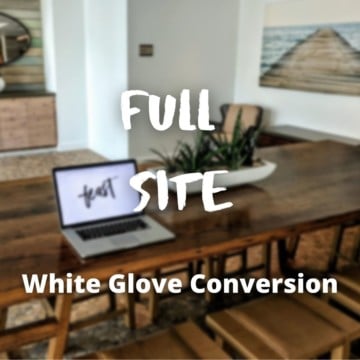When migrating to our theme + plugin setup, we often get asked about to have it done in one step. Doing many complex changes at once can lead to difficult to identify issues and major setbacks.
The reality is that there's multiple separate projects that actually need to be done, and unless hiring a custom developer for $5,000 - $20,000, this has to be broken into multiple smaller projects.
We only provide assistance with steps #3 (theme) and #4 (plugin) below.
Jump to:
0. Platform
Before anything can be done, you need to be on a WordPress site.
We don't offer migrations from Wix or Squarespace (or other platforms) to WordPress. There are tons of issues that arise from this and it needs to be handled by an expert.
We have not vetted this company, but wpexperts.io has platform conversion services listed.
1. Host
Different hosting companies have different basic configurations, services and support levels. We recommend either BigScoots or DeepRoots (formerly Agathon).
This must be a self-hosted WordPress installation (eg. not WordPress.com)
For the Full Site Conversion White Glove and Theme + Plugin Conversion, hosting on BigScoots is required so that a proper staging site is available.
2. Pagebuilders
You must remove or migrate any content in pagebuilders (such as Elementor, Divi, Thrive, Beaverbuilder) before tackling a theme migration. See why we don't support pagebuilders.
We've been told wordherd.io does this, but we've never used them and can't vouch for their work.
Note: staging sites
We recommend performing the theme and Feast Plugin setup on a staging site.
It's important not to work on your live site after creating the staging site. This is because the staging site will entirely replace the live site when it goes back live.
A theme + plugin setup is a big project in itself - do not complicate this with customizations, editing categories or removing tags. Wait a minimum 4 weeks before performing any other major updates after a theme update.
We can't stress this enough: push your staging site live AS SOON AS the migration is complete and do any sort of content or styling changes after it's live.
Note: categories
This is worth repeating:
Do not change or update categories while migrating.
There's so much that has to be done during a theme migration that adding category changes creates totally unnecessary complexity.
Wait 4 weeks after your staging site has been pushed live before changing any categories.
Categories have nothing to do with your theme and will only slow you down.
3. Theme
The majority of themes (even our own older versions) contains code and customizations that are outdated and doing more harm than good. The best thing you can do is simply trash the old setup and start with a fresh install.
A theme install sets up the theme that's seen on the demo site without any previous customizations.
Access to all our themes are included with the Feast Plugin, which is what we recommend purchasing.
In the past, the theme was this "all in one" setup that included both styling and functionality. Now, themes aren't meant for functionality and are used only for styling.
The entire site setup (except installing the theme) is done through the Feast Plugin. See the Feast Plugin Setup tutorial.
NOTE: some outdated themes have built-in recipe cards - you must export or convert these recipes cards to a modern equivalent (Create, Tasty Recipes or WP Recipe Maker) before migrating.
4. Feast Plugin
With the change to the block editor and eventually the "full site editor", we've had to rewrite how the themes were built to adapt to this new setup. While doing this, we've implemented more modern best practices for SEO and accessibility and created an overall better user experience.
See the Feast Plugin Setup for instructions on doing it yourself, or hire us to create it with the White Glove services.
If this is a brand new site, you can have us build you a full-configured brand new site with the Fresh Site White Glove service.
5. Analytics
Make sure to check for, and re-add any analytics traffic code that may have been tied to the old theme.
We recommend using the Site Kit plugin to implement Google Analytics.
6. Ads
If you have ads, be sure to reach out to your ad network to let them know you've made a theme change/update so that they can make any necessary adjustments to their ad positioning and targeting.
7. Pagespeed
Our themes and plugin are designed to be compliant with pagespeed and SEO as much as possible, but this ultimately falls on external plugins, services, and plugin auditing.
There simply is no single solution to this, and any theme or framework claiming otherwise is lying (intentionally, or by omission).
The biggest factors affecting pagespeed, in order of importance, are:
- how you create your content and structure your site, including 3rd party plugins you use
- hosting
- pagespeed plugin (WP Rocket)
- theme
The bare minimum involves installing and properly configuring WP Rocket.
However, the key to attaining great pagespeed is removing poorly performing plugins and scripts. You must perform a plugin audit and pagespeed audit and remove any services and scripts that aren't designed for pagespeed (which is most of them).
The only goal of a recipe page is to provide a bunch of images + text to the reader so that they can make a recipe. Anything outside of this will compromise that experience and the penalty it introduces has to be justified.
8. Customizations
Customizations are anything that change the styling, laying, spacing, fonts, colors and structure of your site beyond our theme. See the Themes vs. Customizations post.
A theme is like a recipe: we create and test according to our setup (ingredients), and the intricacies of how everything ties together (from fonts to colors and spacing) is what makes it work.
Much like a recipe, once you start substituting and modifying the setup (ingredients), it's no longer the same recipe. Things stop working how they should.
We can only help you with our own recipe.
We don't offer customization services.
Once the theme and plugin have been setup and installed, you can begin performing customizations such as tweaking colors, fonts and styling. This can be done with CSS, or by hiring a designer.
In general, we don't recommend making customizations, see: why you shouldn't make customizations.
Any customizations, even seemingly minor things, requires a large volume of back and forth emails with designers to guide design choices, ensure color contrast compliance, avoid outdated plugins, and prevent CLS. These customizations must then be revisited and maintained every year to ensure continued compliance. This is simply not feasible at scale.
Designers who are experienced with SEO, accessibility, pagespeed, and changes coming in the WordPress are rare, and expensive. Any designers we know are currently backlogged 6-12 months, and have minimum project sizes in the thousands.
Ecommerce
We do not recommend or support ecommerce functionality.
That doesn't mean that you can't use woocommerce or run ecommerce functionality, it just means that our themes don't have built-in functionality and we won't offer any support for troubleshooting pagespeed or styling conflicts that arise from it.
Generally, you need to hire a private developer at least on contract ($2000+/month) to support and troubleshoot ecommerce functionality. Unless you're making over $2000/month in profit from ecommerce sales, this is simply not worth it in 99% of cases.
Instead, you should use one of the dozens of third-party services specifically set up to manage ebook/digital product sales, such as GumRoad, Kit (formerly ConvertKit) or Shopify.
FAQ
Q: Will my URLS change?
A: Themes shouldn't modify URLs, so your URLs shouldn't change when changing themes.
However, we've seen at least one theme where certain posts were forced under a "recipes" slug. This is a misconfiguration on that specific theme and not something we're able to provide support for.
Q: What about my Pinterest / Google site verification?
A: This will depend on how they were implemented. If they were done in the "Customizer" rather than the code snippets plugin, they may be lost during an update.
You'll need to track down where this was done, and preferably re-implement it in the Code Snippets plugin (which isn't modified during a theme update) or the Google Site Kit plugin.



Leave a Reply